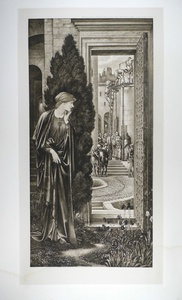| Method | Photogravure |
| Artist | after Sir Edward Coley Burne-Jones |
| Published | Published by the Berlin Photographic Company Berlin. _ London W.133 New Bond Street. _ New York 14 East 23rd Street. [c.1900] |
| Dimensions | Image 493 x 240 mm, Plate 558 x 292 mm, Sheet 667 x 507 mm |
| Notes |
Printed on India laid paper. Plate 64, taken from Burne-Jones' 1888 oil painting of the same title, from 'The Work of Edward Burne-Jones, Ninety-One Photogravures Directly Reproduced from the Original Paintings'. Only two-hundred copies of the 'The Work of Edward Burne-Jones...' were produced, each of which was signed by Philip Burne-Jones, the eldest son of Edward. Burne-Jones' 'The Tower of Brass' takes its subject from Greek mythology, looking to the myth of Danaë, the daughter, and only child, of King Acrisius of Argos and Queen Eurydice. The myth states that Acrisius, frustrated by his lack of sons, questions the oracle of Delphi of any future male heirs. It emerges that the king would never have a son, but his daughter, Danaë, would, and that the king would eventually be killed by his daughter's son. Terrified of the premonition, Acrisius has a bronze tower constructed, in which the childless Danaë is confined. Although an attempt to prevent Danaë from ever having children, Zeus, desiring Danaë, comes to her in the form of golden rain streaming through the roof of her chamber, from which she falls pregnant. Their son, Perseus, is born soon after. Some years later, Perseus, on his way to Argos, learns of the prophecy. In an attempt to prevent his grandfather's death, Perseus instead travels to Larissa, where athletic games were being held. An elderly Acrisius, by chance, also attends the games, during which Perseus accidentally strikes Acrisuis' head with his javelin, fulfilling the oracle's prophecy. 'The Tower of Brass' portrays the construction of the tower, with Danaë standing to left of the composition, anxiously watching over the structure through a doorway. Great emotional tension is formed between Danaë and the men in the background as she awaits her fate. Although the subject of Burne-Jones' 'The Tower of Brass' is that of the Greek myth of Danaë, it is likely that Burne-Jones was looking to William Morris' 'Earthly Paradise' as his immediate source. Morris' epic poem, completed in 1870, recounts myths and legends from Greece and Scandinavia. The painting from which this photogravure was taken is now in the collection of the Glasgow Museum and Art Gallery. Prior to the painting, Burne-Jones visited the subject on two other occasions, producing two smaller versions of the image. The first of the two, painted in 1872, which shows the tower completed, is now in the collection of the Ashmolean Museum, whilst the second version, of 1876, is in the collection of the Fogg Art Museum. Sir Edward Coley Burne-Jones, 1st Bt (1833-1898) was a painter and designer closely associated with the later phase of the Pre-Raphaelite movement. Burne-Jones met William Morris as an undergraduate of Exeter college, Oxford, whilst studying for a degree in theology. The pair went on to work very closely together on numerous decorative arts projects including stained glass windows, tapestries and illustrations. Originally intending to become a church minister, Burne-Jones never finished his degree, choosing instead to pursue an artistic career under the influence of Dante Gabriel Rossetti. Rossetti heavily inspired his early work, but by the 1860's his idiosyncratic style was beginning to develop. His mature work, however different in total effect, is rich in conscious echoes of Botticelli, Mantegna and other Italian masters of the Quattrocento. Thusly, Burne Jones' later paintings of classical and medieval subjects are some of the most iconic of the Pre-Raphaelite movement. He was at the height of his popularity during the 1880's, though his reputation began to decline with the onset of the Impressionists. He was created a baronet in 1894, when he formally hyphenated his name. The Berlin Photographic Company, (1880 - 1920; fl) or the Berlin Photographische Gesellschaft, was a German print publishers who specialised in photogravures after Old Masters and contemporary painters. High quality photographs were taken of the original works. The negatives were then exposed onto a gelatin covered copper plate, etched with acid, and printed in a similar fashion to an engraving. The main series of the Berlin Photographic Company's publications is kept together at Blythe House, West Kensington. Condition: Foxing and discolouration to margins, water stain to lower edge of sheet, slightly affecting image. |
| Framing | unmounted |
| Price | £450.00 |
| Stock ID | 41612 |

